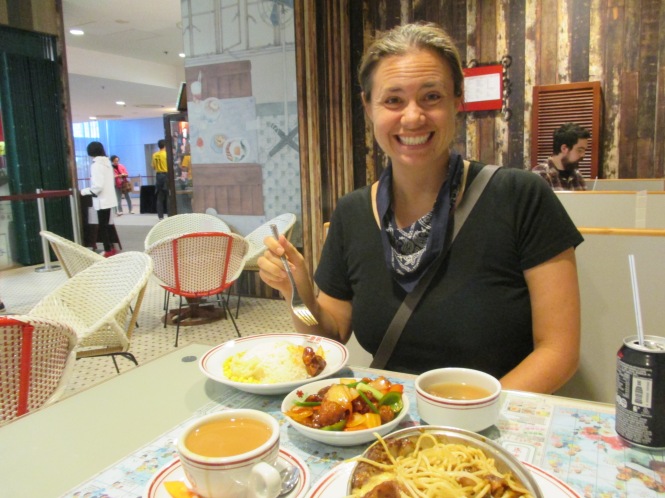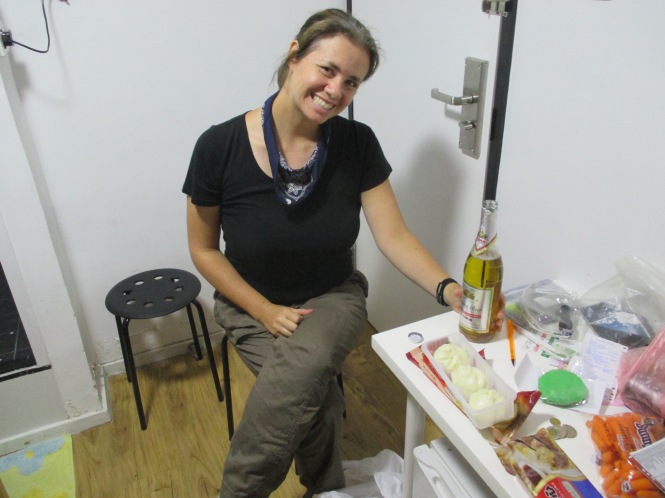We arrived home in Denver about 1 month earlier than we had intended. Because of this, we had one more month of summer to figure out. We were feeling a bit antsy and were working through a lot of feelings related to our experience in Nepal during the earthquake. We knew that Eric’s parents already had a short vacation planned in Red River, NM. We decided to drive down and join them and give ourselves a little bit more time to explore a bit closer to home. If you’d like to learn more about how to support Nepal after the earthquake, there are a few ideas here.
We loaded our car, making sure to be extra prepared. Our recent experiences in Nepal made us super aware of the variety of things that could possibly go wrong. We made sure to carry extra gas, extra warmth, extra food, etc. We drove through some excellent scenery south from Denver towards New Mexico. We arrived to Red River right around sunset and right before a downpour started.
It turned out that May in Red River was a low time for visitors. We were reminded of our experiences with walking dead tourism in Turkey as we had to go to 3 different places to find an open restaurant for dinner!
Taos
The next day we headed out to visit Taos. We were excited to add another UNESCO site to our list as well as explore a town we had never really seen. Our first stop was the town visitor center where we picked up a self-guided walking tour guide and got more information about things to do in the area. But, our first stop was Taos Pueblo.
Taos Pueblo is an ancient Pueblo about 1 mile outside of Taos. It is designated a UNESCO world heritage site. The site is made up of several multi-story adobe buildings that have been continuously inhabited for more than 1000 years.
When visiting Taos Pueblo, you pay an entrance fee which includes a tour of the site by a native of the Pueblo. We enjoyed this tour, on which we learned a bit about the history of the Pueblo and more about the culture and traditions of the people who have lived there for so long.
We learned that the oldest buildings were built perhaps sometime between 1000 and 1400 AD. Currently there are about 150 people who live in the pueblo. The Puebloan families own a home within the Pueblo that they use for holidays and religious ceremonies, though they often live outside the Pueblo. The Pueblo and about 48,000 acres of mountain land above the valley belong to the native people. They structure their own government and education system within the Pueblo.
We learned a bit more about how the adobe structures are built and maintained. In addition, we toured St. Jerome’s Church and learned more about the religion that the Puebloan people practice. They are about 90% Catholic, but ancient (and secretive) native rituals are performed alongside the Catholic traditions.
We were surprised to learn that they are a very secretive people. Our guide was not allowed to describe any of the private rituals, ceremonies, or holidays observed in the Pueblo. He was also not allowed to describe much of the native religious beliefs or education practices.
Please check out the Taos Pueblo website to learn more about this fascinating site.
After our visit to the Taos Pueblo, we headed back into modern Taos. We spent the rest of the afternoon exploring there. First we visited the iconic St. Francisco de Asis Church, which was made famous by artists such as Georgia O’Keefe and Ansel Adams who painted/photographed it. Then we headed back downtown to follow our self-guided walking tour. We walked up Kit Carson Avenue past art shops, through Taos Plaza and inside the old courthouse to see some murals. Then we headed through Guadalupe Plaza and up LeDoux street. At the end of LeDoux, there was a winery tasting room. Della was intrigued and Donna and Steve had never been to a winery, so we headed inside to take a break and get a few tasters. We enjoyed most of them, though Donna decided that she really doesn’t enjoy most red wine. We finished the tour at an old settlement a few blocks away, enjoying the lovely light as the sun started a slow descent.
We then drove out to the Rio Grande Gorge Bridge, which appears in the middle of a flat plain way over the Rio Grande below. We parked and walked out on to the bridge. A bit scary looking down, and when it vibrated with trucks passing by. But the views were really incredible.
We started to head home, but made a last minute decision to stop at Taos Mesa Brewing Company on the same road. It seemed to be in the middle of nowhere but it was packed with people for trivia night! We got a bunch of samplers of beer and dinner.
Wild Rivers Recreation Area
The next day we decided to head to Wild Rivers Recreation Area which was about a 1 hour drive from Red River. Again, the park seemed mostly empty. In fact, when we first headed to the ranger station, it was closed. Luckily, a ranger showed up a few minutes later to give us some advice. He recommended checking out the confluence of the Rio Grande and Red Rivers and then doing the Big Arsenic Springs trail. We ate lunch at the confluence, enjoyed the windy view and then headed to the trailhead. We hiked a mile down on some rocky trail (making us cross our fingers for no earthquakes). Near the bottom we moved through a campground and on to some petroglyphs. After a quick snack, we headed down the river to Little Arsenic camp and then head up the canyon from there. It was a little longer than anticipated, so made for good exercise.
Valles Caldera National Preserve
We were heading to Chaco Canyon next, so had a couple hours driving to get there. We left after brunch and made a few stops along the way. We enjoyed a quick wine tasting at La Chiripada Winery in Dixon. This was a much less structured tasting than the last, but enjoyable as well. We stopped for lunch in Los Alamos. The on and off rain we had been experiencing all day lead us to keep driving. We headed out of town toward the Valles Caldera National Preserve. We arrived late afternoon in some mist and rain without much of a plan of what to do. Fortunately, the park wasn’t busy and a ranger offered to give give us a guided tour of the Caldera in his van. He was able to give us lots of information about the caldera’s geology, history, and status as a park. The park is unique because the land is owned by the Federal Government but is managed by a trust. This has created an interesting experiment in land management. The trust does continuing ranch operations while opening the preserve to visitors. We also stopped at an interpretation cabin and listened to another employee tell us more about the area and about some of the movies and TV shows that have been filmed in the preserve. These include the 2013 version of The Lone Ranger with Johnny Depp and the TV series Longmire.
Chaco Culture National Historical Park
We drove from Valles Caldera to the small town of Cuba, which we had read was the closest town to our next destination, Chaco Culture National Historical Park (also known as Chaco Canyon). We got one of the last rooms at one of the few motels in town, the Frontier. We had a nice New Mexican dinner at El Bruno’s just down the road – much better than what we expected for such a small town!
Getting to Chaco Canyon requires quite the journey. The last 13 miles of the road are unpaved and rough, but our Subaru handled it well. The main attraction at the canyon is visiting the extensive ruins built by the Chaco culture between 900 and 1150 AD (a little before the well-known cliff dwellings at Mesa Verde), now a UNESCO World Heritage site. We picked up some maps and headed out to hike the different self-guided trails through the best-preserved of the ruins.
The first set of ruins, called Una Vida, is just outside of the visitor center. It was windy and cold, so we bundled up and set out on the trail. A small brochure described how the structures we were seeing were part of what seems like a pueblo or some other gathering place for a large group of people, with ceremonial kivas scattered throughout. One of the most interesting parts was the masonry: the walls were built with many small flat rocks stacked on top of one another. We also took a side trail up the canyon wall to see some petroglyphs.
We drove through the park and stopped at the trailhead for the two biggest sites: Pueblo Bonito and Chetro Ketl. We had just started our tour through Pueblo Bonito when a hailstorm hit, leading us to take shelter pressed up against one of the ancient walls. Once the storm passed, we continued our tour of this massive example of what archaeologists call a “Great House,” since it seems to be a living structure for a large number of people. This one, a large multi-story complex, had at least 650 rooms at its height. The path took us through some small doorways and into some of the structures.
The sun came out as we passed by more petroglyphs on of walk to Chetro Ketl, another Great House. This one was a little smaller, having about 500 rooms.
We were running out of time in the day, so we rushed over to our final stop, Casa Rinconada. The attraction here is a massive Great Kiva, a ceremonial structure seen in all Ancient Puebloan sites. When in use, it was covered with a roof and had a fire going inside in a large fire pit. It functioned as a place for religious and cultural ceremonies.
Around 1140 AD, the Chacoan culture collapsed, perhaps caused by a severe drought. Archaeologists think that the people migrated to neighboring communities, but do not know definitively. Many of the Native American tribes in the area, such as the Hopi and Pueblo, have oral traditions that describe the people from Chaco Canyon as their ancestors.
As we left the park, the sun came out again, and a beautiful rainbow crossed from one side of the canyon to the other. It was a picturesque end to our time in New Mexico. We split from Eric’s parents; with them headed back to Texas and the two of us headed north to Colorado for a visit to another UNESCO site. It was an enjoyable time, and a good way for us to get another small taste of traveling as we adjusted to life back home.







































































































































































































































